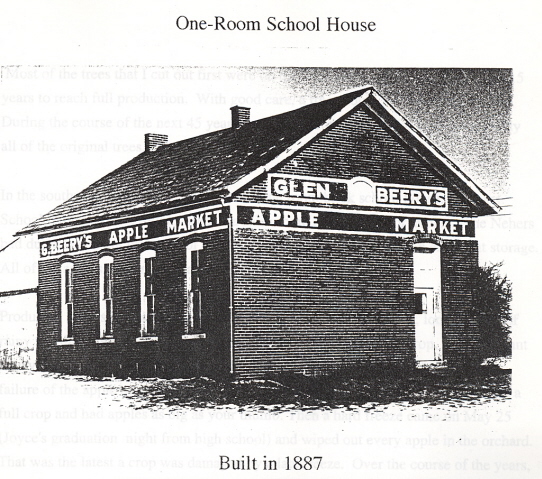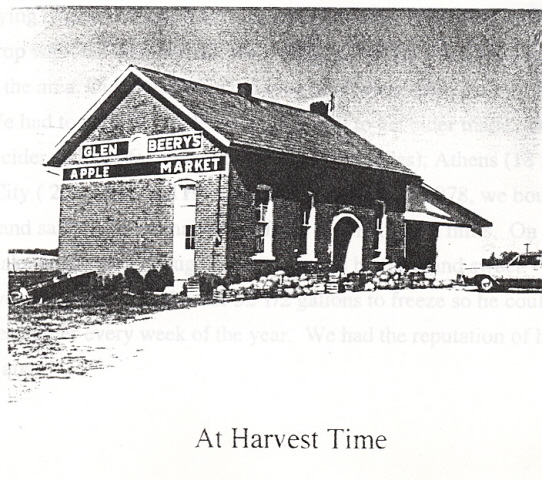|
BEERY’S APPLE ORCHARD
Excerpted from Glen A. Beery, AS I
REMEMBER (1996), used with permission of Delbert Beery.
…Late in the summer of 1943 my good
friend Paul Neher told me his dad, Simon Neher, was thinking
about renting or leasing his 80 acre farm and moving to
town. Besides the crop land, there was a fifteen acre
orchard with apple trees and a few cherry trees. In the ten
years Paul and I had run around together before we were both
married, I had been in the house and around the orchard many
times. I still had a pretty strong desire to get back to
“dirt” farming and feeding livestock, so I could put into
practice the many things I had learned while operating a
feed mill and elevator. The drawback was that I didn’t know
the first thing about caring for an orchard. Mr. Neher
assured me that he would be willing to teach me all the
basic things about caring for an orchard. Purdue University,
through the county extension office, was helpful whenever
you ran into special problems. [Wife] Maurine wasn’t very
much sold on moving out in the country. However, she agreed
that if this was what I really wanted to do she would go
along. We moved to the farm one mile east and one mile south
of North Manchester in January 1944. The lease agreement
stated that I was to furnish all the labor to do the farming
and feeding the livestock. …
Some time late in the fall of 1952, Mr.
Neher said he was thinking of selling the farm. None of his
three sons was interested in buying it and I could have the
first chance. He wanted to sell it on a contract. We agreed
on a price of $300 per acre. I paid $1,000 down. The first
two years I was to pay just the interest on the balance at 4
½%. After that I was to pay $500, plus the interest every
six months. The contract was to be binding on all the heirs.
A few years later, after Mr. and Mrs. Neher had passed away,
I didn’t want to be making payments to the four children who
were heirs to the contract. I went to the bank and took out
a first mortgage and paid them off. Once a friend asked,
“Why did you want to buy a farm with an orchard on it?” I
told him, “It is not like raising hogs or producing eggs,
where if you have a good year everybody and his brother can
be in the same business within six months. If I have a good
year in apple sales, I know that all of my neighbors are not
going to be raising apples the next year. Further more, when
I sell most farm produce, I always ask the buyer how much he
is paying for it today. When I sell apples, I set the
price.”
One of the first things I did after
buying the orchard was to cut down and make firewood out of
about 100 trees that during the time I rented I learned
didn’t produce and/or were varieties that didn’t sell. Neher
had set the west 7 ½ acres in 1912 and later about 1929, he
set the east 7 ½ acres.
Most of the trees that I cut out first
were on the west side. It takes most trees 12-15 years to
reach full production. With good care, a tree should last
another 20 years. During the course of the next 45 years
that I cared for the orchard, I replaced nearly all of the
original trees.
In the southwest corner of the farm was
a one-room brick school house, Walters School, built in
1887. It was used as a sales room and storage for apples.
The Nehers had dug a basement under all of the building in
1932, and it made an excellent storage. All of the apples
were sold retail at the orchard.
Producing apples is a pretty high risk
business. Late spring freezes, long periods of rainy
weather, plus all the diseases and insects that can attack
the crop, are a constant worry during every growing season.
Only twice in 45 years did I have a complete failure of the
apple crop—in 1944 and 1961. In 1961, the trees bloomed and
set on a full crop and had apples as big as your thumb. Then
a hard freeze came on May 25 and wiped out every apple in
the orchard. That was the latest a crop was damaged by a
late freeze. Over the course of the years, we had varying
degrees of loss from late spring freezes, from 10% to 60%.
In years when the crop was less than normal, we would buy
apples from Michigan and other orchards in the area. Cider
was a big drawing card when selling direct from the orchard.
We had to take our apples to a cider mill to get cider made.
Over the years, we went to cider mills as far away as
Rochester (24 miles), Athens (18 miles), Columbia City (25
miles), and Huntington (18 miles). In 1978, we bought our
own cider press and saved a lot of man-hours from running to
the mills. On the plus side, we could make cider often
enough for it to always be fresh and sweet. We had one
customer every fall who would order
52 ½ gallons to freeze so he could have a ½ gallon of
fresh cider every week of the year. We had the reputation of
having the best cider in the area.
Lots of stories are told about both
sweet and hard cider. A lady customer said she would like to
buy a jug of cider if she was sure there were no worms in
it. I told her she didn’t have to worry about the worms in
the cider because the cider press had a worm extractor on
it. She bought some cider. Fresh, sweet cider for most
people is a very good natural laxative. Hard cider or ‘apple
jack’, if mode properly, is a very deceiving drink because
it has a smooth taste and looks much like sweet cider. In
the ‘good old days’, nearly all farms had a small orchard of
10-12 apple trees and a pear tree. You were not ready for
winter and the next year’s canning season unless you put a
barrel of cider in the cellar to ferment and produce vinegar
to use in canning the harvest from the garden.
…One of the more noticeable changes in
the 45 years of selling apples direct from the orchard was
the public’s buying habits. In the 40s and 50s, it was not
unusual for a family to come to the orchard about the same
time we had finished picking and buy four or five bushels to
take home for the winter. By the 80s, we were selling more
apples by the peck and ½ peck than any other way. I think
several things contributed to the change. More and more
houses were centrally heated and had no good place to store
apples. The younger families thought of apples just as an
eat-out-of-hand fruit and never thought of making apple
sauce, baking apples, making an apple pie, apple butter or
apple salad. Most people today don’t realize that the apple
is the most versatile fruit you can buy.
Source: The News-Journal, Oct. 26, 1987
Beerys Preserve 100 Year Old
School House At Apple Orchard
One hundred years old
this month, the red brick one-room school house now serving
as the storage and sales facility for Beery's Orchard is a
living monument to the progress of time.
That's the feeling of Maurine Beery who knows a thing or two
about the evolution of school houses in Indiana, having
taught for 31 years in the area schools, including Servia
and Liberty Mills where the old abandoned school houses
still stand.
"We need to preserve our history, to talk about how it was
then, so that our children and their children can understand
how things were done before we had modern schools," she
felt.
Active in the local historical society, Beery noted, "So
many things are getting away from us that our children will
never experience."
The Beerys' school house known as the Walters School, is a
well-preserved example of how schoos were built and how they
looked in the year 1887.
Of triple brick construction, the building still has its
original slate rool.
The wooden floors are two layers thick, with one by twos
stuffed with mortar underneath to deaden the sound of many
little feet, reported Glen Beery.
"At one time there was a school like this every two miles,
the theory being then that a child would never have to walk
more than a mile to school," reported Glen.
"Course nowdays if a kid goes more than one or two
blocks it's practically a sin," remarked the former school
trustee.
Beery said that legend has it the Walters school was
built by a man who could neither read nor write. "It's said
he came out here every day at noon to drive stakes by the
sun's shadow so he could make the building square with the
world," he said.
"Look at it for yourself--every line is straight," he added.
The school was heated, of course, with a potbellied stove.
But what is unique is that the stove drew in cold air from
the outside, with special vents at all four corners of the
building, and then heated that cold air as it passed up and
around the stove.
The building served its purpose for just 20 years, before it
was decided to send the kids to town.
After that it became a home for a Johnston family, who
lowered the ceilings, built partitions, added another
chimney and stove, and dug a basement, now just perfect for
apple storage.
The history of the orchard itself dates to 1912 when Simon
P. Neher, using dynamite to dig the holes, planted seven and
one-half acres of apple and peach trees.
The first major apple crop came in 1925, and the Nehers
celebrated by buying a new Nash auto.
In 1943 Neher retired and leased the farm to the Beerys, who
purchased the orchard in 1953. They still produce apples and
cider, with the help of their son, Delbert.
The following photographs are from Glen A. Beery, AS
I REMEMBER--THE STORY OF MY LIFE (1996). Posted
here with permission of Delbert Beery.


|